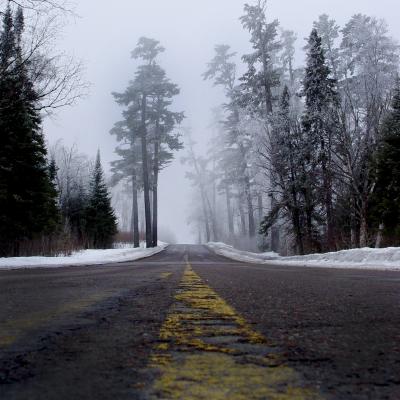Of Woods and Words: Driving On Ice
| Attachment | Size |
|---|---|
| Finalcut_DriveOnIce_OWAW_20100305.mp3 | 7.86 MB |
While my grandfather made his living plowing the roads of Cook County, I am the second generation of reluctant drivers in my family. My mother does not care for winter driving, at all, and I clung so steadfastly to a belief in the absurdity of 90-degree backups that I didn’t bother getting my driver’s license until I turned 21. When I announced this fall that I’d be spending my first winter in six years back in Cook County in a teeny shack halfway up the Gunflint Trail, friends expressed some concern that they’d never see me again. At least not until every last bit of ice had melted off the Gunflint in the spring. Even I had visions of gnawing on a moldering crust of bread in the Shack as I ate through everything in my pantry, too terrified of the snow-packed Gunflint Trail to actually drive the 30 miles to a grocery store.
Because I hadn’t wintered in Cook County since I was 18, my winter driving experience was limited and my confidence in my little car’s winter abilities were low. Early this December, I drove home from a long weekend in the Cities to find the Gunflint Trail wearing its winter coat of ice and snow pack. As I poked along at 30 miles per hour, I cast an eye to the backseat where five bags of groceries sat. For all I knew, those might be the last groceries I saw until April.
But when you spend a winter on the Gunflint Trail, you soon become adept at driving on ice. For one thing, five bags of groceries only last about two weeks at my house.
This winter I have learned the tug of my car as it follows the zigzagging truck ruts I’m at the mercy of on early morning treks to work when I must beat the plows to the Gunflint. I have learned to scan the ditches carefully after dark for the shadowy forms of moose and other wildlife. I have learned the treacherous curves and hills. I have learned to avoid the jarring buzz of my antilock brakes kicking in.
On days when I must go to town, I wait for the plows, trusting that they will clear the roads to the best of their ability and that if I go slow, I’ll be all right. The most important thing winter driving on the Gunflint teaches you is to find a steady pace, to avoid sudden applications of the brake, and not to worry too much about how long the trip’s going to take. Failure to do so results in one of those funny, car-shaped imprints that started to pop up all along the Gunflint ditches during the last week of January. Sometimes I get to town in 35 minutes. Sometimes it takes closer to an hour. But unless we’re in the midst of a massive dumping of snow, if I need to go somewhere, I go. After all, a secluded life in the woods needn’t go hand in hand with an isolated life in the woods.
While I have become comfortable this winter driving the icy Gunflint Trail, I still whisper prayers to various deities whenever I merge onto 35W past Forest Lake. It just doesn’t seem that potentially life-altering decisions, like merges, should take place at 70 miles per hour. Rush hour eludes me. And that’s probably a big part of why I, and so many others up here, have chosen to live a life that requires us to drive on ice for approximately four months out of every year. When given our druthers, we’d rather go slowly and get there when we get there.
Air date: March 6, 2010
Tweet




